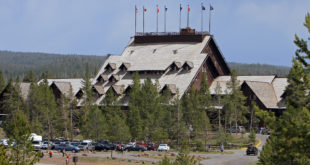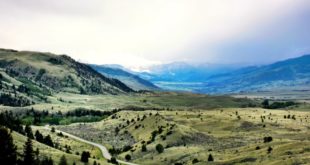It’s official: the Obama Administration went ahead with a delisting of grey wolves from the Endangered Species list, removing protections for wolves in Idaho and Montana but retaining protections in Wyoming.
The delisting, which was first proposed by the Bush Administration and then approved by Secretary of the Interior Ken Salazar, would allow the hunting of wolves in every state save Wyoming. In Idaho and Montana, over 1,000 wolves would be vulnerable out of a population of 1,343.
Basically, the government is declaring victory in reestablishing the wolf population in the northern Rockies.
“We have recovered a wolf population,” Montana-based Ed Bangs, wolf recovery coordinator for the U.S. Wildlife Service, told CanWest News. “The populations are viable, they are in great shape, they have extreme genetic diversity and so the endangered species act did its job to bring wolves back.” He adds hunting shouldn’t affect the wolf population.
As expected, conservation groups immediately announced they would be filing suit to prevent the delisting; it was last litigated in July 2008, when a federal court rejected a similar delisting. Conservation organizations, including the Center for Biological Diversity, EarthJustice and Defenders of Wildlife, filed a 60-day notice of intent to sue that will become ripe on June 2, 2009. The Endangered Species Act requires 60 days’ notice before commencement of litigation to allow time for a violating party to change course and cease its violation.
There may also be a backlash once details of Idaho’s “management” plan are released. According to the Center for Biological Diversity, says the state of Idaho plans to kill hundreds of wolves, including those within 26 family packs that the federal predator-killing agency, the U.S. Department of Agriculture’s Wildlife Services, identified as a priority for elimination this coming winter. (These include 100 wolves assumed to have killed elk.) Many of these wolves have been radio-collared, and are likely to be gunned down from the air.
Wyoming was not given a green light to open the hunting of wolves because of the perceived deficiencies in the plan. Basically, Wyoming filed a plan allowing anyone to kill a wolf pretty much any time. Given the sensitive nature of wolves in Yellowstone National Park, the U.S. Wildlife Service rejected Wyoming’s plan.
The following is a statement by Rodger Schlickeisen, president for Defenders of Wildlife:
“Today’s delisting is a potentially disastrous turn for a venture that began in 1995 in such a hopeful and rewarding manner: the restoration of wolves to their natural landscape in the West. We are outraged and dismayed that Secretary Salazar put his stamp of approval on this premature and inadequate Bush administration plan for wolf.
“We all expected more from the Obama administration, which repeatedly promised it would consult with conservationists, scientists, and other stakeholders on key issues before making decisions. Secretary Salazar rejected our offer to work with him to find the right way to delist wolves in the region and, instead, made his surprise announcement that he was removing federal protections for vulnerable wolves with no transparency at all. Defenders of Wildlife immediately filed a request under the Freedom of Information Act so we could learn who the Secretary talked to about the issue and what scientific review he undertook — and we are still waiting for an answer. Meanwhile we are moving to sue Secretary Salazar as soon as possible to overturn this misguided and unwarranted decision.
“The delisting plan allows these two states to reduce wolf populations to levels that would threaten genetic diversity between populations and undermine the goal of ensuring a healthy, sustainable wolf population in the region. Secretary Salazar’s terrible decision leaves us no choice. We will stand up for wolves and endangered species conservation by moving to challenge this delisting in court as soon as the law allows.”
The new rules came after a lawsuit filed last summer by conservation groups, who argued the plan to allow states oversight on wolf populations was akin to an extermination plan, not a wildlife-management plan. Missoula-based U.S. District Judge Donald Malloy agreed and ordered a new set of rules be drawn up.
On the one hand, it’s hard to argue the wolf has made a remarkable comeback in the greater Yellowstone Ecosystem. According to the latest estimates, 1,531 wolves in 95 packs roam the territory. The vast majority of those wolves are in Montana (500) and Idaho (850), leaving only 250 or so wolves in Wyoming, including Yellowstone. That far exceeds the original goals of at least 15 breeding pairs and 150 wolves per state.
Part of the dispute comes as to how the wolves are counted; the USFWS is now saying 70 wolves and seven breeding pairs must be in Wyoming outside Yellowstone and Grand Teton national parks. Apparently there are not, according to USFWS estimates; hence the need to protect the wolves on an endangered-species list. The Coalition, on the other hand, says there are 188 wolves in 25 packs living outside Yellowstone. Other estimates are lower, though there’s been reports of new wolf packs in the Gros Ventre River drainage area, according to a report issued today.
RELATED STORIES: Wolf battles heat up yet again; expect a summer of lawsuits
Keep up with the latest in Yellowstone National Park news with our free weekly Yellowstone Insider newsletter. Subscribe today! More details here. We’ve also set up a free Twitter account so you can receive updates on the device of your choice.
 Yellowstone Insider Your Complete Guide to America's First National Park
Yellowstone Insider Your Complete Guide to America's First National Park





